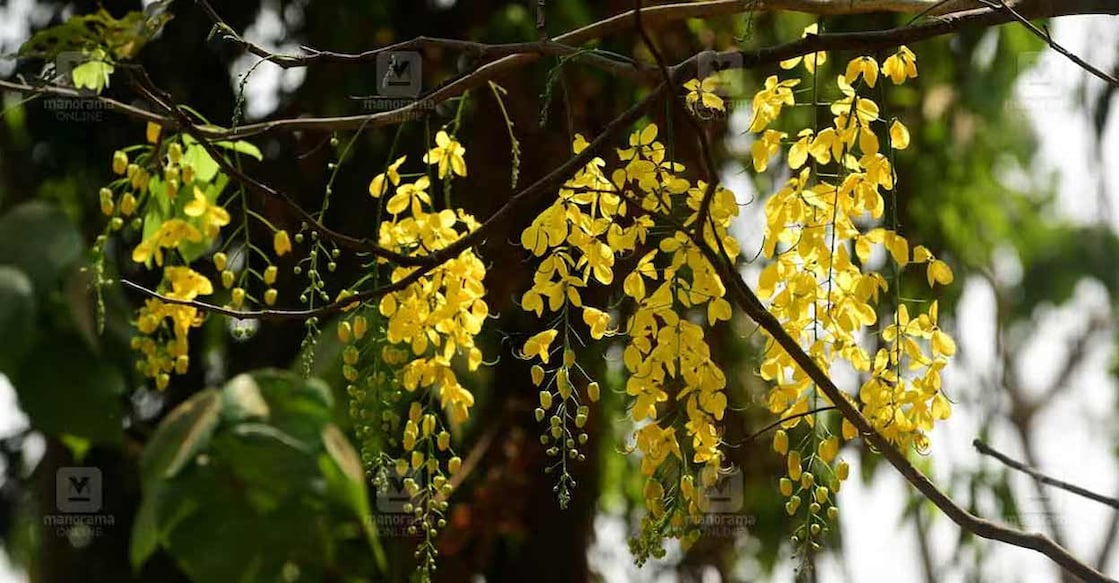Of Kani Konna and cultures brightened by its golden showers

Mail This Article
When Malayali friends heard I would be spending some time in Palakkad in April, I was warned against the heat. “It’s literally a cauldron at this time,” a well-wisher said, suggesting I hold off until the onset of the monsoons. While the weather was definitely on the warmer side (even by Indian standards), April showers came to the rescue during my recent visit. Even if they didn’t, the sight of blooming Kani Konna, or Cassia fistula trees, ade the heat bearable.
Palakkad and the villages surrounding it put on quite a spectacular golden yellow show in April ahead of the Malayalam New Year, Vishu. It’s hard to miss the sight of these flowers in full bloom.
Kani Konna flowers evoke strong memories in those with an emotional and spiritual bond with Kerala and Malayalam. They are for us, on Vishu, what green pine trees are for those celebrating Christmas in cold countries. The radiant colour of these flowers also evokes the kind of joy that the yellowing Ginkgo leaves do in Beijing in autumn!
So many foods and traditions that we associate with the distant past in Kerala are a part of our lives thanks to the Columbian Exchange. But not the Cassia Fistula! They are native to the Indian subcontinent and Southeast Asia. It’s not just Malayalis who love them.
You see the flowers of these trees, called ‘ehela’ in Sinhalese, near Buddhist temples in Sri Lanka and many roadsides. Just like Kerala, where it is the state flower, Sri Lanka’s North Central Province, home to the great ancient cities of Anuradhapura and Polonnaruwa, also considers it their provincial flower.
The people of Laos, who also celebrate their new year between April 14 and 16, use these flowers that they call ‘Dok Khoun’ as a symbol of the festival. In Laotian, Khoun (pronounced 'khoon') conveys “luck, happiness or talismanic power.” According to the Laotian Times, the colour yellow “represents freshness, happiness, positivity, clarity, energy, optimism, enlightenment, remembrance, intellect, honour, loyalty, and joy” in the country.
The Cassia fistula is also the national tree of Thailand, another country that celebrates its new year (called Songkran) on April 13 to 15.
In my hometown, Bombay, we have Laburnum Road, which is named after these trees. The road also has the house Mahatma Gandhi operated out of for 17 years and launched the Non-cooperation movement. Whenever I walk in that neighbourhood, I wonder whether the Mahatma actually took note of those flowers that lined it in the hottest time of the year in the city.
In Delhi, the trees are called Amaltas and make the scorching summer more bearable. It’s a usual practice for me to go for a walk to Lodhi Garden at 5 am in early June and enjoy seeing these flowers both on the walk there from Sujan Singh Park and in the beautiful and historical park.
If only our town planners and municipalities planted more Cassia fistula trees in public spaces, more people would experience the joy of seeing these flowers. We need to revere nature and its beauty the way the Japanese do.
In a village in Palakkad district on a hot late afternoon this April, I stood by the fields that nourished my ancestors, looking at the hills in the distance and taking a count of the Kani Konna trees. Two happy school children, who were finally allowed to go outside and play, raced their bicycles past me and sped off in the distance. I then watched with joy as a lukewarm breeze shook the branches of one tree and those flowers fell on these boys like some sort of divine blessing. This scene justified the other name for this tree- Golden Shower.
A few days later it was time to part ways with Palakkad and as we drove off to Thrissur and Kochi, I noticed a hill that was a mix of yellow and green. If only I could stop the car and make my way to the hill to make the most of this beautiful natural phenomenon, rather than letting it be a passing moment in a long journey.


